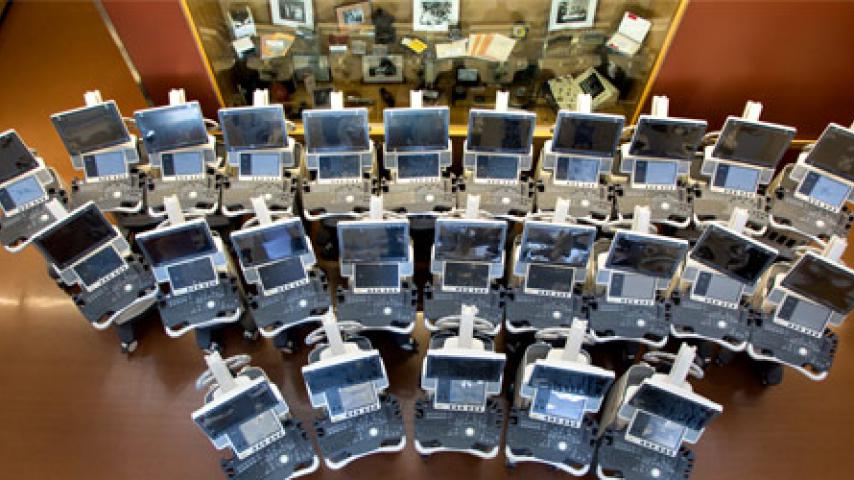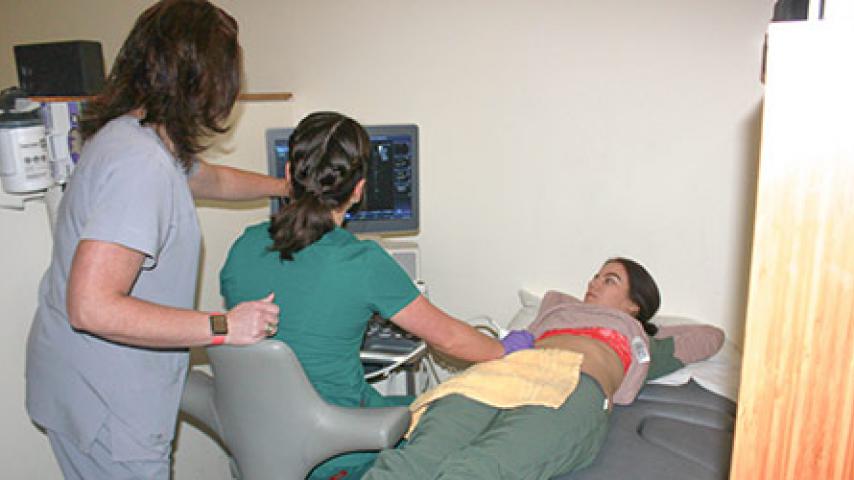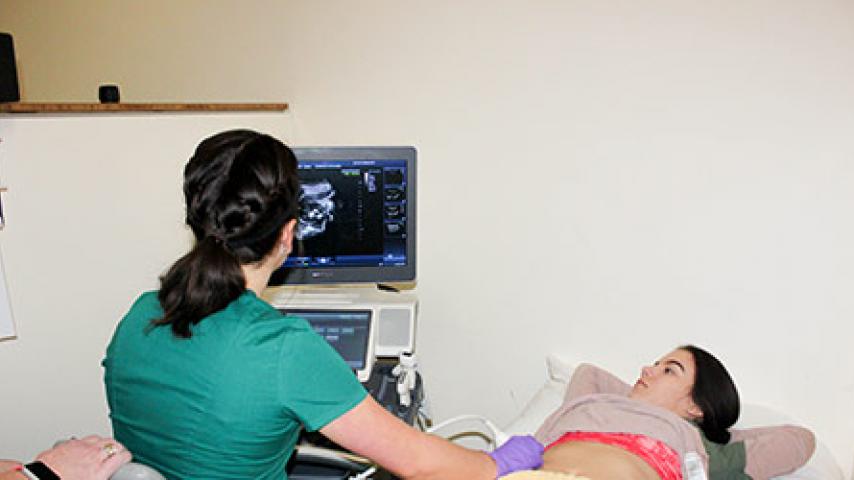
Diagnostic Medical Sonography - Goal and Mission Statement
To prepare competent entry-level sonographers in the cognitive (knowledge), psychomotor (skills), and affective (behavior) learning domains for the Abdominal sonography - Extended and Obstetrics and gynecology sonography concentrations.
What You'll Learn
An Oregon Tech degree in Diagnostic Medical Sonography will prepare you to use diagnostic medical ultrasound equipment to direct high frequency sound waves into areas of a patient's body to generate an image for the assessment and diagnosis of various medical conditions. Sonography is commonly associated with obstetrics and the use of ultrasound imaging during pregnancy, but this technology has many other applications in the diagnosis and treatment of medical conditions throughout the body.
Viewing the screen during the scan, sonographers look for subtle visual cues that contrast healthy areas with unhealthy ones. They decide whether the images are satisfactory for diagnostic purposes and select which ones to store and show to the physician. Sonographers take measurements, calculate values, and analyze the results in preliminary findings for the physicians.
Diagnostic medical sonographers may specialize in obstetric and gynecologic sonography (images of the female reproductive system), abdominal sonography (images of the liver, kidneys, gallbladder, spleen, and pancreas), neurosonography (images of the brain and other parts of the nervous system), breast Sonography, or additional areas of specialization.
- Obstetric and gynecologic sonographers specialize in the imaging of the female reproductive system. Included in the discipline is one of the more well-known uses of sonography: examining the fetus of a pregnant woman to track the baby's growth and health.
- Abdominal sonographers inspect a patient's abdominal cavity to help diagnose and treat conditions primarily involving the gallbladder, bile ducts, kidneys, liver, pancreas, spleen, and male reproductive system. Abdominal sonographers also are able to scan parts of the chest, although studies of the heart using sonography usually are done by echocardiographers.
- Breast sonographers use sonography to study diseases of the breasts. Sonography aids mammography in the detection of breast cancer. Breast sonography also is used to track tumors, monitor blood supply conditions, and assist in the accurate biopsy of breast tissue. Breast sonographers use high-frequency transducers made exclusively to study breast tissue (Bureau of Labor and Statistics, 2010).
Oregon Tech Offers
- Full time clinical externship during the student's senior year.
- Extensive on-campus, in-lab scanning utilizing leading-edge technology.
- Engaged faculty involved in student’s hands-on imaging/learning opportunities during on-campus courses.
- Professionalism within practice is embedded into coursework so graduates are better prepared to be successful healthcare professionals.
Outcomes
Oregon Tech gives students relevant experiences, a lot of one-on-one professor-student education, and industry experience to be competitive in this high demand field. Oregon Tech graduates have excellent opportunities for employment in hospitals, clinics, private practice and state and federal agencies. By 2024 this field will employ 24% more people than currently in the workforce, which is much faster than average growth. (bls.gov, June 2017)
Accreditation
CAAHEP
The Diagnostic Medical Imaging (DMS) program is accredited by CAAHEP (Commission on Accreditation of Allied Health Educational Programs) www.caahep.org upon the recommendation of the Joint Review Committee on Education in Diagnostic Medical Sonography.
CAAHEP Mailing address:
9355 - 113th St. N, #7709
Seminole, FL 33775
P:727-210-2350
F:727-210-2354
E: mail@caahep.org
ARDMS
Oregon Tech graduates have a high pass rate board certification American Registry of Diagnostic Medical Sonographers (ARDMS) board exams. http://www.ardms.org/
Online Guide to Become a Sonographer
Featured Courses
Diagnostic Medical Sonography is a degree within the Medical Imaging Technology (MIT) department. Each degree under MIT requires prerequisite courses before admittance into the degree program. During this time, students are listed as Pre-Medical Imaging Technology (Pre-MIT) students. Admittance to the Oregon Tech Pre-MIT Program does not mean the student has been accepted into a specific MIT program. After the prerequisites are finished, students can apply for the program.
Musculoskeletal Sonography
Survey of sonographic musculoskeletal imaging with emphasis on normal and abnormal findings.
Fetal Echocardiography
Survey of fetal echocardiographic imaging applications with emphasis on parasternal, apical, subcostal and suprasternal 2-D views.
Neonatal/Pediatric Sonography
Neonatal topics include hip, abdominal and neurological sonographic applications. General sonographic pediatric pathologies and anomalies will be discussed.










